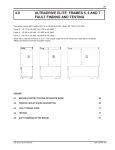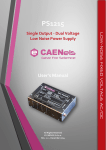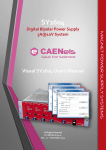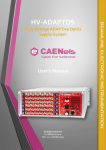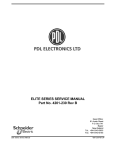Download CT PCB User`s Manual
Transcript
DC Current Transducers CT PCB Series User’s Manual All Rights Reserved © CAEN ELS d.o.o. Rev. 1.7 – March 2015 PRECISION CURRENT TRANSDUCERS < CAEN ELS d.o.o. Kraška ulica, 2 6210 Sežana – Slovenija Mail: [email protected] Web: www.caenels.com 2 CT PCB Series User’s Manual Table Of Contents 1. INTRODUCTION................................................................................................ 8 1.1 1.2 2. CT PCB SERIES OVERVIEW ............................................................................ 8 CT PCB MODELS AND VERSIONS ................................................................. 10 INSTALLATION AND OPERATION ............................................................ 11 2.1 CONNECTIONS ............................................................................................... 11 2.2 RECOMMENDED PCB FOOTPRINT ................................................................. 12 2.3 PCB LAYOUT GUIDELINES ........................................................................... 14 2.4 SECONDARY-SIDE SIGNALS ........................................................................... 14 2.4.1 Power Supply ........................................................................................... 15 2.4.2 Secondary Current ................................................................................... 15 2.4.3 Voltage Output (“V” versions only) ........................................................ 15 2.4.4 OK Signal ................................................................................................. 16 3. TECHNICAL SPECIFICATIONS .................................................................. 18 3.1 3.2 3.3 4. EQUIVALENT NOISE ...................................................................................... 19 EXTERNAL SHUNT RESISTOR ........................................................................ 20 ISOLATION DATA .......................................................................................... 21 MECHANICAL DIMENSIONS....................................................................... 22 3 CT PCB Series User’s Manual Document Revision 0.1 1.0 1.1 Date March 14th 2013 April 4th 2013 June 17th 2013 1.2 July 12th 2013 1.3 January 6th 2014 1.4 1.5 April 2nd 2014 April 7th 2014 1.6 1.7 November 3rd 2014 March 11th 2014 4 Comment Document created First official release Additional information added Mechanical dimensions updated Noise data added and OK+ and OK- changed pinout CT-52 version added External shunt resistor added Manual graphics changed Offset specification updated CT PCB Series User’s Manual Safety information - Warnings CAEN ELS will repair or replace any product within the guarantee period if the Guarantor declares that the product is defective due to workmanship or materials and has not been caused by mishandling, negligence on behalf of the User, accident or any abnormal conditions or operations. Please read carefully the manual before operating any part of the instrument WARNING Do NOT open the boxes CAEN ELS d.o.o. declines all responsibility for damages or injuries caused by an improper use of the Modules due to negligence on behalf of the User. It is strongly recommended to read thoroughly this User's Manual before any kind of operation. CAEN ELS d.o.o. reserves the right to change partially or entirely the contents of this Manual at any time and without giving any notice. Disposal of the Product The product must never be dumped in the Municipal Waste. Please check your local regulations for disposal of electronics products. 5 CT PCB Series User’s Manual Read over the instruction manual carefully before using the instrument. The following precautions should be strictly observed before using the CT PCB series DCCTs: WARNING CAUTION 6 Do not use this product in any manner not specified by the manufacturer. The protective features of this product may be impaired if it is used in a manner not specified in this manual. Do not use the device if it is damaged. Before you use the device, inspect the instrument for possible cracks or breaks before each use. Do not operate the device around explosives gas, vapor or dust. Always use the device with the cables provided. Turn off the device before establishing any connection. Do not operate the device with the cover removed or loosened. Do not install substitute parts or perform any unauthorized modification to the product. Return the product to the manufacturer for service and repair to ensure that safety features are maintained This instrument is designed for indoor use and in area with low condensation. CT PCB Series User’s Manual The following table shows the general environmental requirements for a correct operation of the instrument: Environmental Conditions Requirements Operating Temperature 0°C to 50°C Operating Humidity 30% to 85% RH (non-condensing) Storage Temperature -10°C to 60°C Storage Humidity 5% to 90% RH (non-condensing) 7 Introduction CT PCB Series User’s Manual 1. Introduction This chapter describes the general characteristics and main features of the DC current transducers of the CT PCB mount series. 1.1 CT PCB Series Overview The O-FLUCS < (O-FLUx Current Sensor) is based on a closed loop technology that allows accurate and precise monitoring of DC and AC currents with high bandwidth. The metal casing guarantees higher noise immunity and reduces undesired noise pick-up from external sources. The transducers CT-13 and CT-26 are PCBmount devices rated at maximum currents of 13A, 26A and 52A with primary to secondary transformation ratio of 1:250, 1:500 and 1:1000 respectively. Galvanic isolation between the primary and the secondary circuits allows to measure currents at a different potential and simplifies interfacing if using the < as the feedback element of current regulated power supplies. Output from the < sensors can be chosen between two different versions: standard secondary current output or buffered voltage output (low temperature coefficient shunt resistor and low-noise amplifier are embedded in the CT-13V, CT26V and CT-52V versions). Main characteristics of the < current transformers are negligible temperature coefficient on the secondary output current, excellent linearity and extremely low noise. DC current transformers represents the ideal replacement for systems where Hall-effect sensors are used as current sensing elements and better performances are needed. The compact mechanical dimensions of this transducer series and its limited weight allows easy mounting on printed circuit boards with a Through Hole (TH) topology. A plastic cover is placed on the bottom side of the device to allow easier mounting on the PCB. Main application fields for these current transducers are precise and extremely stable regulated power supplies and power inverters. 8 CT PCB Series User’s Manual Introduction Due to the excellent characteristics, the O-FLUCS transformers can be used in a variety of calibration, acceptance testing and quality control applications in the industrial and automotive fields. Commercially available versions of the PCB-mount O-FLUCS current transformers are the current-output CT-13, CT-26 and CT-52 with their respective “V” voltage-output versions CT-13V, CT-26V and CT-52V. Top view of a sample of the O-FLUCS CT PCB Series current transducer is presented in Figure 1. Figure 1: Top view of a CT-26 O-FLUCS current transducer Bottom view of the same current transducer, with pin connectors and warranty seals visible, is presented in Figure 2. Figure 2: Bottom view of a CT-26 O-FLUCS current transducer All the CT PCB series transducers have the same mechanical dimensions and the CT-13, CT-26 and CT-52 can be easily interchanged together. 9 CT PCB Series User’s Manual Introduction 1.2 CT PCB Models and Versions The < CT PCB series of current transducer has three different models that differ for primary current rating; each model is available in two different output versions – i.e. secondary current-output (standard) or secondary voltage-output (“V” version). The different models and versions of the CT PCB series are summarized in the following table (Table 1): Product Code Model Description WCT13XAAAAAA CT-13 13 A Primary Current < , PCB-mounting WCT26XAAAAAA CT-26 26 A Primary Current < , PCB-mounting WCT52XAAAAAA CT-52 52 A Primary Current < , PCB-mounting WCT13VXAAAAA CT-13V 13 A Primary Current < , PCB-mounting, Voltage-Output WCT26VXAAAAA CT-26V 26 A Primary Current < , PCB-mounting, Voltage-Output WCT52VXAAAAA CT-52V 52 A Primary Current < , PCB-mounting, Voltage-Output Table 1: CT-PCB series versions and models On the rear side of the power supply unit are visible the air outlets for cooling, output connection terminals, interlock and output status connector, three-phase inputs, rail fuses and the analog output monitor coaxial connector. 10 CT PCB Series User’s Manual Installation and Operation 2. Installation and Operation General considerations and description of pinout and recommended PCB layout are herein presented. 2.1 Connections Any transducer of the CT PCB series has 16-position pinout connections which that is used to mount the device to a Printed Circuit Board (PCB). Not all of these sixteen (16) pins are present in all versions, since the standard secondary currentoutput version has different signals with respect to the “V” voltage-output version. Please refer to the following Figure 3 and the following table – i.e. Table 2 – in order to perform correct connections to the PCB for each model. Pin #16 Pin #1 Pin #8 Pin #9 Figure 3: Pinout scheme of the CT PCB series transducers (top view) 11 CT PCB Series User’s Manual Installation and Operation Pin # CT-13 or CT-26 CT-13V or CT-26V or CT-52 or CT-52V (Current Output) (Voltage Output) 1 Ip - 2 Ip - 3 Ip - 4 Ip - 5 Ip + 6 Ip + 7 Ip + 8 Ip + 9 IS nc 10 + 15 V 11 GND 12 -15 V 13 OK - 14 OK + 15 nc Vo 16 nc Vo RET Table 2: Transducer pinouts Please note that pins not present on the respective model and version are indicated in Table 2 as nc = not connected. 2.2 Recommended PCB Footprint In order to correctly place, mount and connect the CT current transducers to the Printed Circuit Board (PCB), the recommended PCB footprint is represented in Figure 4 (dimensions in mils) and Figure 5 (dimensions in mm). Please note that, referring to Table 2, mounting holes for pin #15 and pin #16 can be discarded for the CT-13, CT-26 and CT-52 transducers while hole for pin #9 can be discarded when using the “V”-versions (CT-13V, CT-26V and CT-52V). 12 CT PCB Series User’s Manual Installation and Operation Figure 4: Recommended PCB footprint (dimensions in mils) Figure 5: Recommended PCB footprint (dimensions in mm) 13 CT PCB Series User’s Manual Installation and Operation 2.3 PCB Layout Guidelines Since the primary flowing into the primary conductor can be as high as 52A for the CT-52 and CT-52V models, it is necessary to correctly connect the current to be measured to the input pins (#1 to #8). The recommended PCB layout is herein shown in Figure 6. I P- I P+ Figure 6: Recommended PCB layout for primary conductor It is highly recommended to make multiple planes/tracks on different PCB layers in order to bring the primary current to the CT pins. The use of thermal reliefs (30 mils) to allow easier soldering to the PCB is also strongly suggested. NOTE: primary current needs to be shared equally among all input pins, especially for high current values. Failure to do so may heat up the device to excessive temperature values. 2.4 Secondary-side Signals The signals on the “secondary” side of the CT current transducers are found from pin #9 to pin #16 (please note that not all of them are present on all versions). 14 CT PCB Series User’s Manual 2.4.1 Installation and Operation Power Supply Supply voltages for the CT have to be fed to pin #10 (+15V) and to pin #12 (15V); both these voltages are referred to pin #11 (GND) and have a rated tolerance of ±6% on the nominal values. Maximum current that can be drawn from each one of these supply voltages is of 100 mA. 2.4.2 Secondary Current On the standard CT-13, CT-26 and CT-52 versions the secondary current output IS, scaled by the current transformation ratio (1:250 for the CT-13, 1:500 for the CT-26 and 1:1000 for the CT-52), is found on pin #9. Maximum secondary current is rated at ±52 mA and an external shunt resistor, which can be placed close to the user’s desired measuring circuit, is needed in order to convert the current signal to voltage. The voltage output pins (VO and VO RET) are not installed on CT-13, CT-26 and CT-52 versions. 2.4.3 Voltage Output (“V” versions only) A buffered output voltage signal is present on the voltage output versions of the CT- series – i.e. CT-13V, CT-26V and CT-52V transducer – in order to allow easier connection of the DCCT to an external circuit or an Analog to Digital converter. The full-scale output bipolar signal VO (pin #15) is referred to VO RET (pin #16) and the behavior is as follows: +10V output if the primary current is +12.5A (CT-13V), at +25A (CT-26V) or at +50A (CT-52V); -10V output if the primary current is -12.5A (CT-13V), at -25A (CT-26V) or at -50A (CT-52V). This behavior can be resumed in the gain parameter G, in [V/A], expressed as the ratio between the transducer output voltage 𝑉𝑉𝑂 − 𝑉𝑉𝑂 𝑅𝐸𝑇 and the primary current IP. 𝐺= 𝑉𝑉𝑂 − 𝑉𝑉𝑂 𝑅𝐸𝑇 𝐼𝑃 This gain value is G = 0.8 V/A for the CT-13V version, G = 0.4 V/A for the CT-26V version and G = 0.2 V/A for the CT-52V version. VO RET pin is not internally connected to ground GND (pin #11) and it should be connected to ground directly in a single-point connection (e.g. on an 15 CT PCB Series User’s Manual Installation and Operation external ADC ground pins or VIN- pin). The availability of this “return” signal is very useful in order to avoid additional ground-loop noise pickup on the voltage-output version of the transducer. Please note that the maximum differential voltage between the VO RET and the GND pin has to be kept within ±0.5V. |𝑉𝑉𝑂 𝑅𝐸𝑇 − 𝑉𝐺𝑁𝐷 | ≤ 0.5 V In the voltage output “V”-version of the transducers the current output pin IS (pin #9) is not present. A screenshot of a primary 1A 20-kHz current sine-wave superimposed on a DC current offset of 0.5A and the respective voltage output of a CT–13V transducer are shown in Figure 7: 1A 0.8 V Figure 7: Primary current and voltage output (measured between pins VO and VO RET) Please note that output impedance for the “V”-version models is 50 Ω. 2.4.4 OK Signal An OK signal, obtained from the outputs of an optocoupler phototransistor (OK+ and OK-, pins #14 and #13 respectively) is present on all versions of the CTseries. Please note that the OK- signal is not internally connected to the ground potential and can be connected to an external reference potential. A pull-up resistor is needed (between the OK+ and some supply voltage referred to the OK- potential) in order to correctly obtained the correct signaling. Two examples on how to connect the OK+ and OK- signals are hereafter presented in Figure 8 and in Figure 9. 16 CT PCB Series User’s Manual Installation and Operation Figure 8: OK signals connections using the +15V and the GND pins Figure 9: OK signals connections as digital interfacing to +3.3V Note that the connection scheme presented in Figure 8 is referred to the GND potential and the OK_SIGNAL is at low level (<0.4V) if the CT transducer is correctly working while it is at high level (>14.5V) when the transducer is not. In the configuration presented in Figure 9, the current transducer can be easily interfaced to a digital microcontroller, a Digital Signal Processor or an FPGA, supplied by a +3.3V voltage source. Please note that the +3.3V supply and the OK_SIGNAL is referred to DGND potential, which can be the same or different from the GND potential on which the CT device is supplied from. The OK_SIGNAL is found to be at low level (<0.4V) when the transducer is correctly working and at high-level (>3V) when not. 17 CT PCB Series User’s Manual Technical Specifications 3. Technical Specifications Technical specifications for < CT-13, CT-26 and CT-52 current transducers (both current and voltage output versions) are herein presented. Technical Specifications Current Transformation Ratio - N Maximum DC Primary Current - IP(DC) Maximum RMS Primary Current - IP(RMS) CT-13 CT-26 CT-52 1:250 1:500 1:1000 ±13 A ±26 A ±52 A 9.2 A 18.4 A 36.8 A Current Polarity Maximum DC Secondary Current - IS(DC) Maximum RMS Secondary Current - IS(RMS) External Shunt Resistor Value - RS Small Signal Bandwidth (±3 dB) – typ. BW Equivalent Input Noise (@Bandwidth) Output Voltage ("V"-version) - VOUT Output Voltage Gain ("V"-version) - VOUT/IP(DC) Maximum Output Current ("V"-version) Temperature Coefficient TC Non-Linearity Induction into Primary (0-100 kHz) typ. 18 Bipolar ±52mA 37 mA 0…40 Ω 500 kHz 200 kHz ("V"-version) < 1 ppm/FS @ 200Hz < 10 ppm/FS @ 50 kHz ±10.4 V 0.8 V/A 0.4 V/A 0.2 V/A ±15 mA < 0.5 ppm/°C typ. < 2 ppm/°C ("V"-version) < 5 ppm < 15 ppm ("V"-version) 140 µV (RMS) 70 µV (RMS) Offset < 10 ppm Protection Signal OK Status Supply Voltage (± 6%) ±15 V Current Consumption 50 mA + IS 35 µV (RMS) CT PCB Series User’s Manual Technical Specifications Secondary Coil Resistance RSEC 42 Ω Connections 16- pin through-hole PCB mounting Operating Temperature Range Mechanical (Outer) Dimensions 0°C – 50°C 0°C – 50°C 0°C – 40°C 66 × 64 × 48 mm Maximum Weight 300 g Table 3: Technical Specifications 3.1 Equivalent Input Noise The typical equivalent input noise of the CT PCB transducer series is hereafter presented as a function of the measuring bandwidth and of the model. The table and its graph are valid for all models and for both current and voltage output options. Equivalent Input Noise for CT-13 and CT-26 and CT-52 Bandwidth Equivalent Input Noise (ppm/FS) 200 Hz 1.0 1 kHz 6.5 10 kHz 7.5 50 kHz 9.5 Table 4: Equivalent Input Noise (typical values) 19 CT PCB Series User’s Manual Technical Specifications 10 Equivalent Input Noise (ppm/FS) 9 8 7 6 5 4 3 2 1 0 2 20 200 2000 20000 Bandwidth (Hz) Figure 10: Equivalent Input Noise graph (typical values) 3.2 External Shunt Resistor The maximum value of the external shunt resistor that can be connected on the IS output pin in the current-output versions is shown hereafter in the following chart. 260 250 240 Maximum Shunt Resistor [Ω] 230 220 210 200 190 180 170 160 150 140 130 120 110 100 30 35 40 45 50 IS [mA] Figure 11: Maximum external shunt resistor (Current version only) 20 55 CT PCB Series User’s Manual Technical Specifications 3.3 Isolation Data VD AC Isolation RMS Test Voltage 50/60 Hz, 1 min (between “Ip+ & Ip-“ terminal and secondary) 3 kV Table 5: Insulation data 21 CT PCB Series User’s Manual Mechanical Dimensions 4. Mechanical Dimensions The mechanical dimensions of the CT PCB series DC Current Transducers are hereafter presented (all dimensions are in mm): 64 47.6 8.1 1.15 5.08 56 35.6 66 Figure 12: Mechanical drawings 22



























